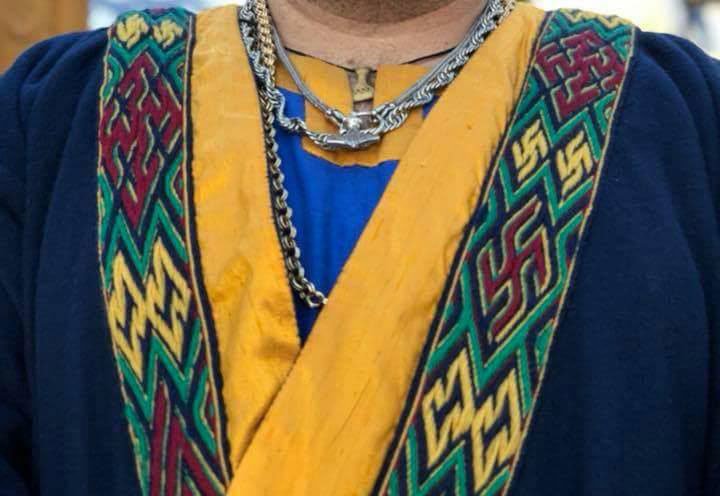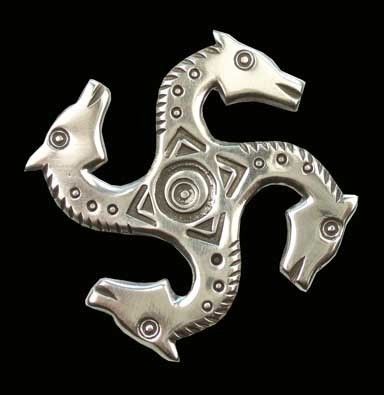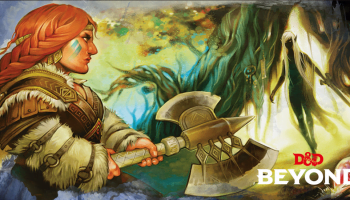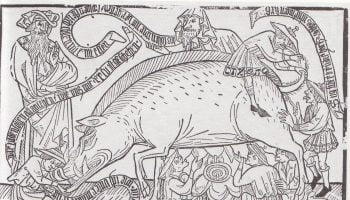Part XLI in our ongoing series on Race, Racism and the Middle Ages, by Ken Mondschein. You can find his new book, Game of Thrones and the Medieval Art of War on Amazon here.
You can find the rest of the special series here.
Content notice: as you might suspect considering the title, this article contains images of historical and historical reproduction garments with swastikas in the pattern.
A recent incident in the Society for Creative Anachronism (SCA) underscores the reason why public history is ground zero in the fight against alt-right appropriation of medieval imagery. Last month, two leading members of the organization had to answer for wearing fascist symbols as part of their costumes.
The SCA, estimated by the organization to be some 60,000 strong, is the world’s largest medieval living history organization. SCA members brew mead, cook feasts, fight in armor, and hold enormous camping events, creating an idealized image of the Middle Ages for their members to revel in. In some cases, their members also conduct historical research and reconstruction at high levels; SCA members have even presented at academic conferences on medieval studies.
On January 6, 2018, the “Kingdom of Caid” (a division of the SCA that encompasses primarily southern California and Nevada) held a “coronation” ceremony for its new king and queen—who go by the monikers Athanaric and Sigriðr within the Society. The group’s “kings” win their crowns in a fighting tournament. They and their preselected “queens” then “reign” for a fixed term—usually six months. There have been rare exceptions, such as when a woman won Crown Tournament in Texas in 1990 or when co-kings reigned in the American Midwest, but the interrelation of combat and rulership makes the system de facto patriarchal and hetero-normative.
During the ceremony, Athanaric and Sigriðr were seated on thrones on a stage in front of the population of the “kingdom” to be crowned. Afterwards, the “chivalry” (i.e. the top fighters who are also seen as role models) swore their loyalty to the new “royals”.
Such ceremonies are deeply meaningful to the participants. As scholar and Society member Michael A. Cramer wrote in his book Medieval Fantasy as Performance,
The effect of the SCA’s institutionalized ceremony and ritual… does more than simply build community. SCA ceremony, within the game of the SCA, exalts certain people and creates an almost cult-like atmosphere around the monarchs, which may be serious or tongue-in-cheek depending on who is playing the role.
But this is where the problem arose: during their coronation, the two SCA “royals” in question were photographed wearing costumes that included recreated 5th-century trim.
That trim included recognizable swastikas and HH (“Heil Hitler”) elements.
The Outcry and Apology

The presence of the swastikas and HH symbols only became clear when photographic portraits were posted online a week later. According to posts on Facebook, due to the distance, relatively small size, and the way the embroidery caught the light, these elements were not noticed by many people at the event itself. Additionally, the two reportedly did not wear the offending garb for the fealty-swearing portion of the ceremony.
Upon the publication of the photos, there was an immediate outcry from both SCA members and non-members. In light of the outcry, the two “royals” in question issued a statement on January 25 which read:
Sometimes you get so exited about something you downplay or ignore the negatives. In this case we have done so and have hurt some members of the populace. We got very exited about a piece of very complex historical art and making an extremely accurate presentation and felt the differences to modern interpretations would be sufficient and that everyone would agree with us. We were wrong. For this we apologize. Know that no offense was intended, no hidden message to interpret, and no hate to be displayed. For any communities hurt we are sorry to have caused you pain. The art created will not be further displayed upon the throne.
Their apology hinges upon two things: first, that the reproduction is an accurate reproduction of historical art, and second, that they did not mean offense by wearing it.

The former is true. The design came from the baldric of a sword found in 1933 in an archaeological dig in southern Norway. Both the swastika and “HH” elements are documentable to the original. The Hs are the rune Hagall in the Elder Futhark alphabet (used in Scandinavia from the 2nd to the 8th centuries CE). Both symbols were later appropriated by the Nazis. The sword itself has a history with the Third Reich: the Nazis coveted it as an authentic piece of “Aryan” heritage. They even had reproductions made of it. But it was hidden by the Norwegians until after the war.
However, this “historical accuracy” argument does not ring true to many.
“There are many equally old, equally documentable weaving patterns that do not have the history of these motifs,” wrote Lisa Evans, a textile scholar and SCA member from Easthampton, Massachusetts. She continued,
Despite its historicity, swastikas for personal heraldry were banned within three years of the SCA’s founding. I could see someone studying tablet weaving making a small sample to test a theory or improve their skill, since this is a complicated pattern. I could also see entering a piece in a competition with appropriate historical and contextual notes. However, there are plenty of other motifs that can be worn in lieu of swastikas.
For other SCA members, historical accuracy is no excuse for wearing a symbol widely known to be deeply offensive. As Arik Mendelvitz, a member of the SCA from Chicago, wrote on Facebook,
I have personally sat with elder members of my own family and had every third person in photo albums pointed to and described as “killed by the Nazis”… Wearing such a symbol on your person, especially as the public face of an entire kingdom, is utterly repulsive and can in no way be excused by “historical accuracy.”
Others also questioned the second aspect of the defense: whether the royals were as ignorant of the connotations of these symbols as they claimed to be. One SCA member, who did not wish to be quoted in this article, claimed in a Facebook post that Sigriðr had allegedly worn swastikas before, at least five years prior—and had been confronted for it. She allegedly rejected the objections at the time. If true, such a revelation undermines her claims of innocence in the more recent incident.
Schrödinger’s Swastika?

It is also debatable whether their intent actually matters. In an earlier article in this series, Paul B. Sturtevant calls objects like this trim “Schrödinger’s medievalisms.” A Schrödinger’s medievalism is a piece of medievalia—like a Thor’s hammer—that is ambiguous because it has been appropriated by the far-right as a hate symbol, but is also used in other contexts. This ambiguity makes them unnerving, since it’s difficult to tell whether the person in question is a white supremacist or a Thor enthusiast.
There is an open debate amongst academic medievalists of how to deal with these sorts of “Schrödinger’s medievalisms.” Some medievalists feel that the use of any symbol that is used by the far right is not acceptable because it creates a space in which Jews, people of color, the LGBTQ community, and other historically targeted groups feel unsafe
However, in his essay on the subject, Sturtevant makes the case that ambiguous representations should interpreted in their context if their intent is unclear. The alt-right used milk as a white supremacist symbol last year; that does not mean that the few remaining milkmen are peddlers of hate speech.
The counterargument is that this approach can lead to “white innocence” (a denial of complicity or guilt that safeguards privilege). In today’s world, it is incumbent on each individual—particularly white people—to take into account the effect their words and actions might have on vulnerable groups.
In this incident, the denial of wrongdoing falls into the category of white innocence—or, perhaps, if they are true, in light of the allegations of past wearing of swastikas by the people in question, “white willful ignorance.” The royals made use of symbols whose connection to the Nazis is universally acknowledged, but attempted to excuse their actions through their intent. The same can be said of those SCA members who have argued that this is “not a big deal.” In other words, they promoted the precedence of declared intent over action or outcome.
There can be no imaginable defense for repeatedly wearing motifs that have become identified with the Third Reich, let alone at such an important ritual as a Coronation. The swastika is rarely an ambiguous symbol today, despite its historical origin.
The Aftermath
The SCA’s Board of Directors also found the costume unacceptable. On January 27, the SCA issued an official press release stating that the organization:
strongly condemns hate speech in any form by any officers and participants of this organization. The SCA… strives to include and be respectful of all people, regardless of race, gender, disability, sexual orientation, and politics. All participants are reminded of and expected to hold to these principles in participating in this organization and interacting with other people in person and in all forums, regardless of media. The Board of Directors… is concerned about this matter and has tasked the President of the SCA to immediately investigate.
When emailed for comment, the organization’s president, John Fulton, added that the “The SCA Board will not tolerate or allow groups or individuals who practice, display, or encourage hate, racism, or discrimination to damage our organization and participants.”
In the wake of this continued pressure, Athanaric and Sigriðr issued a second apology on January 28 and, on the evening of the 30th, stepped down. Their resignation is almost unprecedented in the SCA, and some within the SCA have found it disturbing. When reached for comment on the incident, Michael A. Cramer explained why:
People in the SCA are extremely invested in the underlying concepts, highly idealized, of honor and chivalry…. One reason this is causing such a rupture in the Kingdom of Caid is because the romantic ideal has been destroyed by something that the SCA is designed specifically to resist: modern politics… Most feel that their rightful king and hero has been unjustly taken from them. They feel like the Britons at the death of Arthur, or Troy after the defeat of Hector… They will probably get over it, because realistically, nobody has actually died… But right now, the ones who buy into the “dream” are devastated.
In other words, for some, the Society’s culture requires approaching the “dream” of the Middle Ages with a sort of un-ironic innocence. However, in a post-Charlottesville world, such innocence—especially when it manifests as white innocence about hate symbols like swastikas—is not acceptable within the organization.
This incident has spurred an intense conversation within the SCA about the display of hate symbols like the swastika. Cramer emphasized that, overall, the SCA is a tolerant, open, and diverse place:
Of course there are racists in the SCA, as there are everywhere, but open racism will get you kicked out quickly. The SCA is, on the whole, non-judgmental about people’s background.
Let us hope that he is right, and that the result of the fierce conversation happening in the SCA leads it into becoming a better, more consciously inclusive place.
Addendum: After this story went to press, it came out that another member of SCA royalty from An Tir (the Pacific Northwest) received and, despite some misgivings, wore a robe with similar trim in the summer of 2017, pre-Charlottesville. In the following months, he wore it twice more—once covered with fur, one not. In no case did anyone call attention to the swastika designs. In statements on Facebook, both he and the fabric artist who created the piece apologized and pledged to never wear it again, though he also stated that he would not “destroy a masterwork of art created by a friend who spent hundreds of hours on it” and expressed regret for what happened to the royalty of Caid. Nonetheless, it is encouraging to see the SCA and its members beginning to grapple with these difficult questions.
 Addendum 2: Regarding the allegations of previous wearing of swastikas, according to several sources the conversation in question centered on whether or not a pin or brooch worn by the individual constituted a swastika or not. The object in question was a replica of a historical brooch or pin in the form of four horseheads arranged as a pinwheel (similar to that in the image to the right).
Addendum 2: Regarding the allegations of previous wearing of swastikas, according to several sources the conversation in question centered on whether or not a pin or brooch worn by the individual constituted a swastika or not. The object in question was a replica of a historical brooch or pin in the form of four horseheads arranged as a pinwheel (similar to that in the image to the right).
If you enjoyed that article, please share it with your history-loving friends on Facebook, or on Twitter! And be sure to subscribe here to receive every new article from The Public Medievalist the moment it launches.





I have seen the post by the person claiming they had worn the symbols before, both shared and copied as an image, in the heat of the discussion. What I never saw was any corroboration of that claim. What I have seen is a few posts saying that person was using the situation to further their own grudges with the Queen.
Other than that I think it was a great article. Personally I believe at this point it was willful ignorance from a place of privilege. As a Crown they should have displayed more wisdom and discretion in the choice.
A friend with more contacts than I has dug into the claim that she had worn the symbols before. From what he could get she had worn a horse head amulet that had a swastika on it before. Details beyond that are still sketchy.
The pin/brooch in question is pictured above and I would not consider that fylfot to be a swastika. The arms are bent horse necks with heads, a Swastika has straight arms with ends bent at 90 degrees.
Those things are actually called “horsehead swastikas.”
Just curious…by whom, and since when? Is it because, now that we’re all too familiar with swastikas c/o the third reich, that term has popped up, or did it exist pre-1933?
Tony. I’m in the middle of reading 19thC books, such as the Numismatic Chronicle, to find out when those terms came into play. Slogging through the assumptions of intellectuals from that period is painful though.
How old is that nomenclature? Were they called that before the 1930s?
Speaking as a Jew, if I saw someone wearing that horsehead swastika alongside a Thor’s Hammer and going by the name Sigurdr or something of that nature, I would be suspicious and uncomfortable. Why choose that particular orientation of symbolism among all the others if not to skirt the boundaries of acceptability?
Beginning to grapple? As was pointed out in the article, the SCA has forbidden swastikas in heraldry for almost 50 years.
My first husband was the Laurel Herald when this happened. I remember the meeting where they discussed it, and everybody was repelled by the whole idea of allowing it as a heraldic device, no matter what its history was.
But not on clothing or as part of an A&S display, probably because no one in those days when the memory of the war and the Holocaust was still so fresh thought it would ever be necessary.
I think this kind of quality work (i.e., the article) deserves better attribution. The author’s name is difficult to pick out because of the choice of font.
There is no excuse for wearing a swastika. We in Asatru have considered that symbol taboo for decades even though we know perfectly well it was originally a symbol of the turning of the seasons through the light and warmth of the goddess. For us it is a holy symbol that has been taken away from us by defilers who profaned it, even as we still see the goddess shining her light on the world despite all that has been done with her symbol. We do not use it. We know it has been irredeemably lost to us. We are still fighting to keep our other symbols such as runes and the Thorshammer for our own use, but that one is gone. I do not know if this game-king is heathen or not, but the photo shows him wearing a hammer, so he should have known better.
Just reappropriate the symbols, fuck the nazis
I feel disappointed that this piece omitted disabled people from its list of key victims of the Nazis’ extermination programme. Estimates vary, but around 270,000 disabled people were murdered by the Nazis, which is far higher than some of the other groups who were specifically named in the article (sources: 1). Disabled people were targeted by the Nazis as soon as they came to power in 1933 and they were used as ‘guinea pigs’ to test and hone the gassing process subsequently used on so many other victims (source: 2).
Today, disabled people are the world’s largest minority group. There are over 650 million disabled people which means we are 10% of the world’s population (source: 3). In the UK, where I live, reported disability hate crime rose 29% between 2015-16 and 2016-17 (source: 4). Disabled people are often excluded from work (sources: 5) and are often paid less than non-disabled people when they are working (source: 6). Research has found that 2/3rds of the UK population feel uncomfortable about talking to a disabled person while 36% think disabled people are not as productive as everyone else (source: 7). The UK government has recently been criticised by the UN for its poor treatment of disabled people (source: 8). These are modern as well as historical issues, like the SCA is a modern as well as a historical society.
Given this context, every article that is intended to be inclusive, but doesn’t include / consider disabled people, is at the very least a missed opportunity. Perhaps this could be corrected?
Source 1: https://en.wikipedia.org/wiki/Holocaust_victims. https://en.wikipedia.org/wiki/Persecution_of_black_people_in_Nazi_Germany
Source 2: http://hmd.org.uk/genocides/disabled-people
Source 3: http://www.un.org/disabilities/documents/toolaction/pwdfs.pdf
Source 4: http://www.bbc.co.uk/news/uk-41648865
Source 5: http://www.independent.co.uk/news/uk/home-news/disabled-people-jobs-applications-more-able-bodied-stats-before-employment-a7970701.html https://www.scope.org.uk/press-releases/disability-employment-gap-static
Source 6: https://www.theguardian.com/society/2016/may/24/no-one-should-earn-sub-minimum-wage–disabled-people
Source 7: https://www.scope.org.uk/Scope/media/Images/Publication%20Directory/Current-attitudes-towards-disabled-people.pdf?ext=.pdf
Source 8: https://www.theguardian.com/society/2017/aug/31/un-panel-criticises-uk-failure-to-uphold-disabled-peoples-rights
From the BoD’s statement: “The SCA… strives to include and be respectful of all people, regardless of race, gender, DISABILITY, sexual orientation, and politics.” (emphasis mine)
We certainly didn’t intend to exclude the disabled, but the series is on race…
The series may be on race, but if you are going to quote someone you should use the entire quote; not just the words that suit you.
Where did Ken misquote anyone?
There is no “taking the swastika back” in our lifetime. It is universally remembered as a symbol of hate, and is still actively used by hateful organizations to this day. It is forever tainted.
Exactly.It’s painting the roof while it’s raining.Yes, the generation that was directly involved in the ’30s and ’40s will soon be gone. But last year, three people died on a train here in Portland, at the hand of a man wearing Nazi and heathen symbols all over himself. And there’s Charlottesville, and quite a bit of willful denial and ignorance coming from on high as to who was responsible for that.
Rmmmrmrrmrm… sorely tempted to post the letter I posted the other night.
I don’t think it’s any coincidence at all that all this talk of “reclaiming the swastika” is happening as the generation that actually fought the Nazis and suffered under their rule is dying off. It would have been unthinkable as recently as a decade ago.
So I have one question…what about Schrödinger’s cross? I can not help but point out that many white supremacists display and use crosses. Should everyone else stop wearing or displaying the cross? When ever I see a cross being worn by someone I feel uneasy because I have no way of knowing if they are just Christians or a white supremacist. It is pretty easy to say stay away from a Thor’s hammer or a Valknut because they have been appropriated, but again, so has the cross. Lets face facts, any and all symbols only have the value you choose to ascribe to them, and sadly, the problem is often with the viewer and not the displayer.
I hate to tell you this, but a) the SCA doesn’t allow certain types of crosses for that very reason, and b) the old chirurgenate’s symbol was banned about twenty years ago due to its resemblance to a KKK emblem.
I agree with you but people almost never check their self righteous indignation. LOL
Are any of you folks, including the article writers, aware that the swastika is commonly used in Hindu Diwali imagery, which can be found in many parts of the US these days? I first noticed this when my neighbor put up his seasonal decorations, I complimented him on their beauty, and he immediately went to great pains to assure me he wasn’t a Nazi (which wasn’t even a question).
You can jump up and down and say how the symbol is absolutely unacceptable, ever, but you’re running against the customs of a billion people in the process. Agreed that European-Americans certainly shouldn’t be using it.
Swastikas in a Hindu or Buddhist context are perfectly acceptable. In other contexts they are not. There is nothing difficult about understanding this.
The intent and the context matter, and if the intent is ambiguous, as in the SCA case, outside observers are fully entitled to wonder whether the people in question are neo-nazis or white supremacists.
Swastika or its analogues, is an ancient symbol. That was one of the reasons why Hitler’s propaganda machine embraced the symbol in the first place. The symbol was used in Japan, in Indus cultures, by steppe nomads and even North American native nations, such as Navajo.
In 1940, some Native American nations and tribes came together and foreswore the use of that symbol, known to them as the Whirling Logs, because it was appropriated by Nazis.
Most people who get offended from the use of this symbol know about its multicultural and widespread use before WW2 by many cultures and lament the fact that Nazis managed to claim it for themselves and corrupted it in the eyes of the people.
I’m from Turkey, Anatolia. We have that same symbol in our culture, woven on our traditional rugs and stitchwork. But even we, as a country and nation who managed to stay out of WW2 know and accept the fact that it was corrupted by Nazis and now symbolizes hate and fascism, so we don’t have it anymore in new carpets.
The symbol don’t need defending, it needs its history known, in full detail, so that ever again in the history of humanity an egotistical maniac and his crazy followers come to claim a symbol so cherished by so many people and culture to finally corrupt it.
The symbol is dead.
Of course we are, and sorry, the Norse (and the modern SCA) are not Hindu or Buddhist.
Michael, the article is not about their character; I’m sure they are fine people. It’s about their error in wearing something they should have known better than to wear. (Also, see the definition of “white fragility” here: http://libjournal.uncg.edu/ijcp/article/view/249.)
Talk about Schrödinger’s swastikas; they are all over the US Capitol ! https://uploads.disquscdn.com/images/314cd5b7ecc89639cebfc241425d51c67ae902903250d2d8da7cadd22588beec.jpg building!
First, that is a small piece of a much larger contiguous design. There are many geometric designs that could have swastikas cherry picked out of them if you cut the borders just so. While I am no-holds-barred about actual swastikas, if we start trying to pick them out of every four sided geometric pattern, we’ll become the lunatics some people accuse us of being.
Second, that predates the corruption of the symbol. Nobody has asked that we destroy classic art or architecture, only that we don’t create – or most especially especially flaunt – new examples of it.
Museums are full of sunwheels and fylfots that are historically significant. We can accept and appreciate these things because they are positioned with appropriate context. They are left in the past. The SCA is not real historical context. It is playacting. Nothing about our coronation ceremony is historically accurate. The Snartemo V band wasn’t even a faithful reproduction because it was used as clothing trim and not a sword strap.
Many in the SCA do incredible work and research. If someone faithfully reproduced this band for the purpose of mastering the technique in the actual period fashion, then entered it into an arts and sciences competition with the intention of tucking it away in their portfolio later, most of us would consider that contextually appropriate. Once that artist demonstrated their mastery, they would be expected to produce other non-offensive period reproductions (of which there are multitudes) or period-inspired bands for actual use.
We teach classes on the Inquisition without actually arresting people on the streets and torturing them. Many women portray courtesans without actually selling themselves to those portraying the upper class. People make period herbal preparations, but if someone develops food poisoning we take them to a real hospital. The most important part of the “Creative” part of the organization’s name is not convenience, it’s modern morals. We keep the things that are dangerous in *context*. The context in the capitol building is that it is an important piece of real pre-Nazi architecture. The context in the SCA is, we study but do not actually practice things that hurt people.
That is known as a meander pattern, interlaced Greek frets/keys. Very popular when neoclassical was all the rage. Few dozen types to choose from.
Take back the Swastika and Take back ISIS. Neither deserves their google searches to be polluted by the short lived assholes who have appropriated them. The symbols need to be viewed within the context they are used. If it is a red arm band, in a parade (asshole) – in an intricate trim or part of an Indian peace ceremony (historically accurate). What happens when rainbows and feathers get appropriated by assholes? Don’t let the assholes win!
As Ken points out, this is not about what they think. It’s about what they *did*. That bothers me a lot, especially in light of current events.
To Professor Mondschein’s recent comments;
The following reflects my personal views and should not be taken as official opinion of SCA.Inc or of any other member.
As a Scadian fencer and Armored Combat fighter, I would just like to
take issue, if i may, with some of the comments made in Professor
Mondschein’s article concerning the
SCA ‘s internal structures. The
suggestion that Crown tournaments to “elect” a ruler are inherently
patriarchal and heteronormative is somewhat outdated and generalised if
one takes into account the SCA worldwide, including, in particular,
Europe. I myself am one of a growing number of female Armored Fighters
in the principality of Insulae Draconis (UK and Ireland), which is part
of the Kingdom of Drachenwald (SCA Europe) I have taken part in three
Coronet tournaments (tournament for Prince and Princess, in a similar
structure to Crown). Of a field of 8 or 9 I have had the honour of
fighting, in all cases, not less than 2 female opponents and, on one
occasion, I have been part of a field which acheived gender parity.
In a UK which still has equality issues – women’s pay for example, as
recently highlighted in our press -I consider this field an
acheivement, one which has been worked for over many years by many
fighters, female and male. Every male fighter, every trainer, every
member of the Chivalry, every Master of Arms or Defence I have met has
gone out of their way to help myself and other lady fighters, to
recognise inevitable physical differences in training a female and to
work towards producing the best fighter and fencer possible.
i
am part of a small but growing, pool of female Armored fighters here –
in due course training and committment will pay and one of us will win
Coronet and/or Crown by courage, strength, skill, honour, effort and
decency. I am a feminist but. when I see a male colleague win in exactly
this way my attitude is not, “that should have been a woman,” but
“well fought, congratulations,
your Highness/Majesty,” and I go to work on what technique(s) failed
me or what didn’t work in my mental game on the day and needs
improvement.
We females are considered equal on the field. We
are considered equal off it. We are certainly not, when fought for,
“pre- selected queens”. We are consorts, supporting our fighter in
effort, mental and physical, as they do, when we fight for them. This
stuff hurts, it takes it out of you. To fight for a friend, a lover, a
spouse, to go that distance and take blows is a great gift and is
received as such. If you are not SCadian and this seems… quaint
consider your local football team, or any athlete who competes and gives
all for their team, town or country.
While sexual orientation is
not required on the letter sent as intent to enter a major tournament, I
am happy to say that I myself identify as bisexual and have encountered
within my Kingdom or Principality no prejudice in that regard. Indeed I
have met with a greater degree of inclusivity and comfort in revealing
my orientation than is accessible to me in Britain 2018 in my mundane
life. There is no prohibition in the SCA against me fighting for
someone of the same sex, be they partner, spouse or friend. My consort
in tournaments is a platonic female friend.
I am concerned
overall that Professor Monschein’s article does not reflect the global
picture and does not give as fair and reasoned an idea of the SCA
worldwide as it could. The world in general and likely every hobby and
organisation, public or private, still has work to do in areas of
equality and discrimination be it for race, gender or orientation.
Despite recent events, I am confident that my SCA is aware and focused
on these issues and proud to be part of that work being undertaken with
my sister and brother fighters in the field, my fellow fencers and my
fellow SCA members. I would not step on the field of combat otherwise.
Lesley,
You said that *one* Coronet tournament you were in in Drachenwald (a rather small kingdom, with correspondingly small turnouts for Coronet tournaments) had gender parity (and you omitted how the women placed in the tournament). Overall, in the SCA, such tournaments are not the case. Yes, there are many more women taking the field, but the number of women at the upper levels of heavy fighting is very small, and the incidence of women winning a crown is exceedingly rare. (The aforementioned case in Texas is unique to my knowledge, and I will note she fought her husband in the final.)
In fact, I would debate whether women can, in fact, be “equal on the field.” Every other combat sport has age, gender, and/or weight divisions. HEMA, for instance, has made “women’s” and “open” tournaments in order to encourage female participation. There is a definite size and power disparity—and SCA heavy is definitely a size and power game—plus the fact that one calls one’s own hits opens the field to potential bias. This is not even mentioning systemic cultural sexism and everyday microaggressions, such as when a friend of mine was told she shouldn’t be wearing a red belt because she “didn’t look like a squire.”
You are correct that there are great strides being made, and I applaud them. But the fact that heavy fighting is so size and strength determinant (and the SCA has some very large men in it), that all awards and honors proceed from the “royalty,” and that the crown is gained by individual fighting skill, mean that the SCA is going to be de facto patriarchal—not to mention able-ist. I’m not saying women can’t beat men (Lauren, who is tiny, beat me in the
finals of a one-hit-bout HEMA tournament!), but if we look at the
overall statistical picture, it virtually guarantees patriarchy.
As for heteronormativity, I will point you to the lengthy archived USENET debates on whether there should be same-sex monarchs. There is little overt anti-gay bias in the SCA—but, again, choosing monarchs by SPORTS! doesn’t bode well for inclusiveness.
I am virulently against fascism and white supremacy. I cannot see how the pin with the four horse heads is a swastika. Now, maybe to the perxon wearing it it is a secret symbol, but I do not believe to the casual viewer it would be.
However, it strains credulity that the wearer – or at the very least – the creator of the trim with the swastikas and HH would not be aware that they are there. As you point out – in researching the pattern the association with the 3rd Reich would be unavoidable.
But I will not conclude automatically that they are Neo-Nazis. They may well not hold those attitudes; HOWEVER, they are at the very least INCREDIBLY insensitive to people’s feelings. Being members of our multi-cultural society requires people to – at the very least – be open and willing to be educated to a reasonable extent about the sensitivities of other members of our society.
Exactly where the line is between reasonable behavior and unreasonable behavior will always be changing. Wearing your swastikas outfit in public in front of a synagogue on Holocaust rememberance day AND while being identified as a representative of some organization (such as SCA) is clearly inappropriate and unacceptable. Doing so in private and/or with close friends that understand the pre-Nazi historical significance clearly is OK.
I may be agreeing with author of this article on this, but in any I would say that wearing it at a SCA coronation is ina both because you are now officially representing a large group of people that clearly did not give their consent. As “rulers” they showed very poor judgement and an alarming degree of insensitivity.